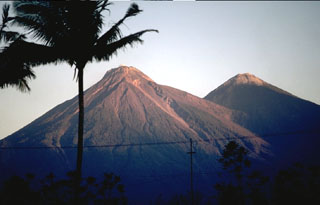Report on Fuego (Guatemala) — 23 April-29 April 2025
Smithsonian Institution / US Geological Survey
Weekly Volcanic Activity Report, 23 April-29 April 2025
Managing Editor: Sally Sennert.
Please cite this report as:
Global Volcanism Program, 2025. Report on Fuego (Guatemala) (Sennert, S, ed.). Weekly Volcanic Activity Report, 23 April-29 April 2025. Smithsonian Institution and US Geological Survey.
Fuego
Guatemala
14.473°N, 90.88°W; summit elev. 3763 m
All times are local (unless otherwise noted)
The Instituto Nacional de Sismología, Vulcanología, Meteorología e Hidrología (INSIVUMEH) reported a few explosions and the ejection of incandescent material at Fuego during 22-29 April. White steam-and-gas plumes rose as high as 100 m above the summit during the week. At night a few incandescent blocks occasionally collapsed and formed minor avalanches. During 23-24 April there were 1-3 weak explosions reported. Additional weak explosions during 27-28 April took place 6-8 times per hour, producing faint rumbling sounds and ash plumes that rose just over 800 m above the summit and drifted up to 15 km SW. Incandescent material was observed at night being ejected 100-200 m above the summit. Avalanches of material descended the flanks, reaching vegetated areas. Four weak explosions accompanied by weak rumbling was recorded during 28-29 April.
Geological Summary. Volcán Fuego, one of Central America's most active volcanoes, is also one of three large stratovolcanoes overlooking Guatemala's former capital, Antigua. The scarp of an older edifice, Meseta, lies between Fuego and Acatenango to the north. Construction of Meseta dates back to about 230,000 years and continued until the late Pleistocene or early Holocene. Collapse of Meseta may have produced the massive Escuintla debris-avalanche deposit, which extends about 50 km onto the Pacific coastal plain. Growth of the modern Fuego volcano followed, continuing the southward migration of volcanism that began at the mostly andesitic Acatenango. Eruptions at Fuego have become more mafic with time, and most historical activity has produced basaltic rocks. Frequent vigorous historical eruptions have been recorded since the onset of the Spanish era in 1524, and have produced major ashfalls, along with occasional pyroclastic flows and lava flows.
Source: Instituto Nacional de Sismologia, Vulcanologia, Meteorologia, e Hidrologia (INSIVUMEH)

